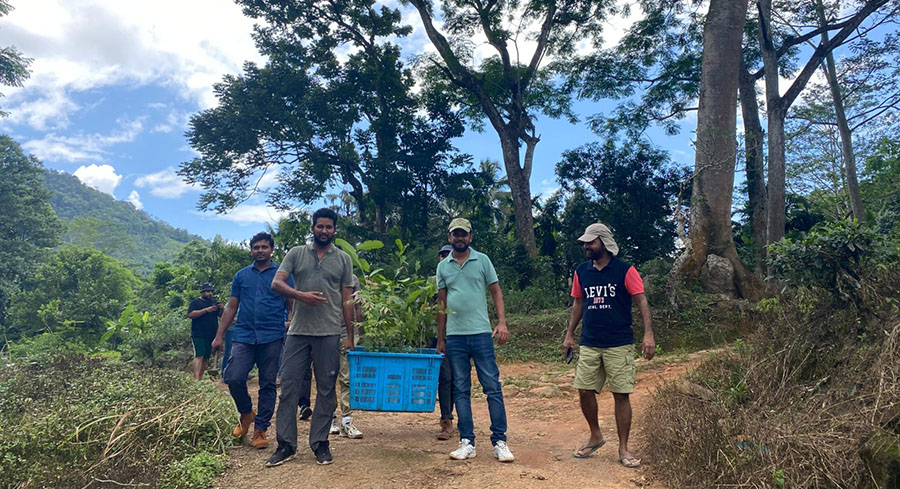Several Regional Plantation Companies (RPCs) are actively working to protect and restore ecosystems, safeguarding the rich flora and fauna that thrive alongside estate cultivations.
From conserving natural forests and endangered species to creating wildlife corridors and engaging local communities, these plantations are providing biodiversity and tea that can flourish together.
Championing Wildlife and Habitat Protection in Bogawantalawa Tea Estates PLC
Bogawantalawa Tea Estates PLC has made biodiversity conservation a central pillar of its plantation management.
The company has placed 75 hectares of land under formal conservation, covering ecosystems that span across more than 7,000 hectares of estate lands.
Its programmes include habitat restoration, the creation of wildlife corridors, invasive-species control and environmental education for staff and surrounding communities.
These efforts have delivered tangible results, with an 18% improvement in species richness, the restoration of more than 37 habitat units and a 42% increase in community engagement when compared with baseline levels.
A flagship initiative, the Bogawantalawa Biodiversity Project, has successfully safeguarded over 500 species of flora and fauna. Among these are Strobilanthes spp.
(Nelu), an endemic plant and the Cophotis ceylanica (Pygmy Lizard), an endemic and vulnerable species, both of which have recorded population growth since the start of the programme.
Soil conservation practices have further strengthened these efforts, delivering agronomic benefits such as improved productivity while simultaneously enriching the flora and fauna within the Plantations.
Science-Based Reforestation and Habitat Care by Kahawatte Plantations PLC
Kahawatte Plantations PLC has also demonstrated strong commitment to biodiversity, with 146 hectares formally conserved across agricultural lands, reforested areas and forest reserves.
The company works in close partnership with the Dilmah Ceylon Tea Company, Dilmah Conservation, Sabaragamuwa University, Rajarata University, the University of Colombo and the Tropical Ecosystems Research Network to advance its conservation initiatives.
Its programmes include habitat restoration, the development of wildlife corridors, invasive-species control and widespread environmental education for communities.
The outcomes have been remarkable, with biodiversity surveys recording 60 species of trees, 53 species of butterflies, 16 dragonflies, 12 amphibians, 28 reptiles, three fish species, 74 bird species and 15 mammals.
More than 1,500 people have been engaged through awareness and livelihood programmes that link local communities to conservation.
One of Kahawatte’s most notable projects is the Endane Biodiversity Corridor, which has created a three-kilometre-long forested pathway, connecting two forest patches.
This initiative is transforming 40 hectares of degraded tea land into tropical lowland rainforest.
In the process, 13,804 seedlings from 173 species, including 85 globally threatened, have been planted, while another 1,120 seedlings have been distributed to five ex-situ restoration sites.
Long-term monitoring plots have also been established to track ecological progress.
The corridor, which integrates scientific reforestation, community participation, livelihood support and even a Payment for Ecosystem Services (PES) scheme, has been recognised internationally, earning the prestigious Franklinia Grant for its pioneering approach.
Kahawatte’s conservation work protects species from families such as Anacardiaceae, Annonaceae, Calophyllaceae, Dipterocarpaceae, Myrtaceae, Melastomataceae and Rubiaceae.
Through in-situ and ex-situ methods, supported by research, nursery management, camera trapping and community engagement, the company continues to expand both the ecological and social value of its biodiversity programmes.
Biodiversity Stewardship in Action in Malwatte Valley Plantations PLC
Malwatte Valley Plantations manages 4,430 hectares of tea while preserving approximately 45 hectares of natural forest within its estate boundaries.
These conservation areas include montane forest patches and riverine ecosystems, which play a vital role in sustaining biodiversity.
The company has undertaken several key initiatives on its own, including replanting degraded lands with native species and establishing biodiversity buffer zones along the edges of tea fields.
The estate has recorded positive outcomes, particularly with the increased sightings of native bird species and several endemic amphibians over the past two years.
Workers have been trained in biodiversity protection practices and awareness boards with pictographic signs have been installed to educate both employees and visitors.
Programmes to raise conservation awareness have also been extended to surrounding communities.
Among the endemic species under Malwatte’s stewardship is the Sri Lankan Junglefowl (Gallus lafayettii), alongside other species recorded within the estate’s montane and riverine ecosystems.
Talawakelle Tea Estates PLC, where the ecosystem safeguards generations
Talawakelle Tea Estates PLC, operating across 5,134 hectares, places biodiversity at the forefront of its plantation management, recognising the ecological importance of its estates, which span both the Central Highlands and areas bordering the Sinharaja Rainforest.
In total, 62 hectares have been placed under formal conservation.
These highland areas serve as vital watersheds that nurture Sri Lanka’s main rivers, while the southern estates lie adjacent to the country’s largest rainforest.
This proximity to sensitive ecological regions drives Talawakelle’s commitment to biodiversity as an integral part of its operations.
Partnerships with organisations such as the Wildlife and Nature Protection Society, Biodiversity Sri Lanka and universities including Colombo, Sabaragamuwa, Wayamba and Peradeniya strengthen the estate’s conservation programmes.
These include habitat restoration, invasive-species control and environmental education for workers and nearby communities.
Regular audits and ecological surveys are carried out, maintaining an inventory of 113 faunal species, of which 44 are endangered, vulnerable or threatened according to the IUCN, as well as 31 floral species.
A landmark initiative is the 13 km Forest Corridor along Nanu Oya and Agra Oya, which is restoring 11 hectares of riparian buffer zones and aims to plant over 50,000 native trees across multiple estates, including Somerset, Bearwell, Dessford, Radella, Palmerston, Great Western and Logie.
This large-scale reforestation project was launched in collaboration with the Wildlife and Nature Protection Society and brought together 15 companies, two universities and several NGOs, collectively raising Rs. 5.2 million for ecosystem conservation.
Local communities were engaged in nursery development, tree planting and biodiversity monitoring, strengthening the link between people and environment.
Talawakelle also enforces strong protective measures across its estates.
Hunting, capturing and trafficking of wild animals and birds are strictly prohibited, while natural habitats are preserved by refraining from converting forestland into tea fields.
Factories are located in less sensitive areas to minimise disruption, and buffer zones are maintained to safeguard biodiversity.
Additional measures include reducing the use of synthetic inputs, ensuring raw materials are free from invasive species and creating ecological pathways to connect fragmented habitats.
Through these practices, Talawakelle continues to strengthen its role as a custodian of biodiversity in Sri Lanka’s tea highlands.
The biodiversity programmes of Sri Lanka’s RPCs demonstrate a deep respect for the country’s natural heritage.
By protecting endangered species, restoring degraded forests and actively engaging communities in conservation, Bogawantalawa, Kahawatte, Malwatte Valley and Talawakelle Tea Estates demonstrate that plantations can be vital stewards of ecosystems.
Their efforts ensure that Sri Lanka’s plantation industry safeguards the island’s rich natural treasures for generations to come.






















